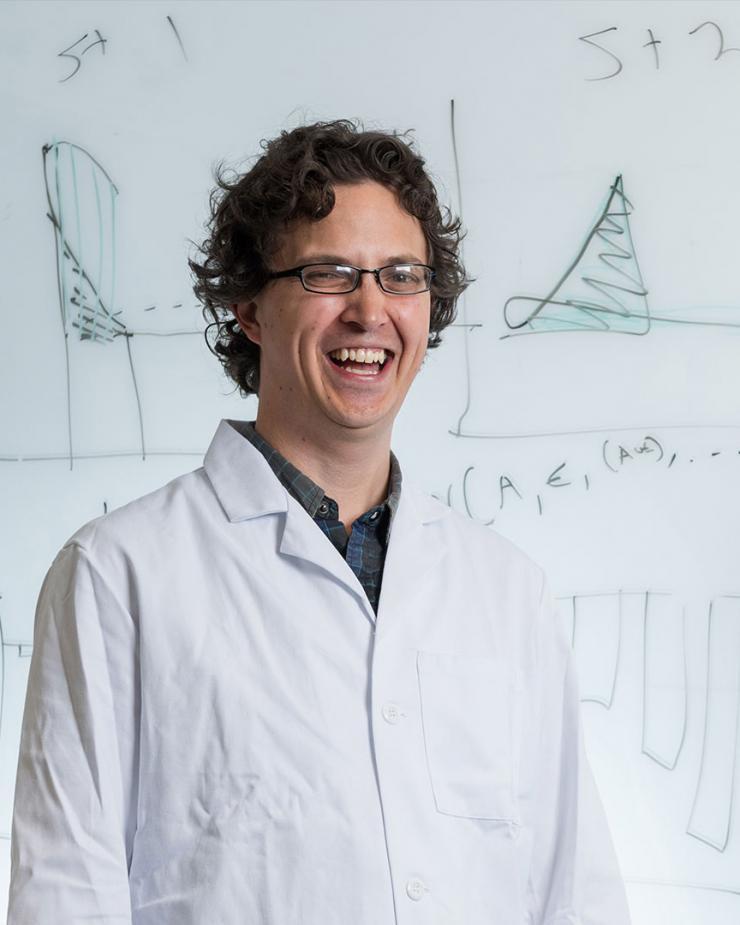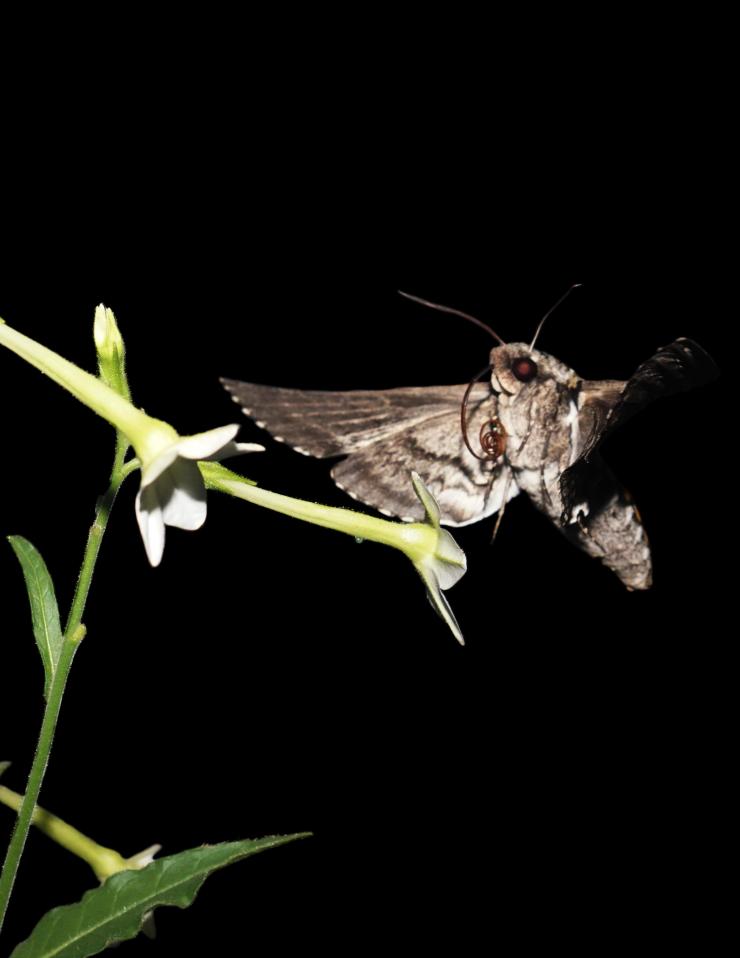Simon Sponberg Wins Major Funding to Study Insect Brains
Jun 28, 2018 — Atlanta, GA

A hawk moth in mid wing stroke unrolls its proboscis to feed from a Nicotiana flower. These agile moths hover in midair and track flower movements at up to 10 times a second even in light levels as dim a starlight. To stay aloft, they capture vortices of air on their wings. (Credit: Megan Matthews)
“Movement is a defining feature of animals,” says Simon Sponberg. He is an assistant professor in the School of Physics and of Biological Sciences. How animals navigate their environments is the motivating question of his research program.
Studying animal movement makes for riveting experiments. For example, Sponberg used high-speed infrared cameras to observe, at low light conditions, moths tracking 3-D-printed flowers oscillating at various speeds. The set-up emulates the natural world of Manduca sexta, or hawk moth. Like a hummingbird, this moth feeds by extending its proboscis into flowers, which may be swaying with the wind – at dusk.
Such dynamic behavior requires neural systems to organize and coordinate many muscles to control the moth’s wings all in fractions of a second. It creates extreme motor and sensory demands on the moths. How do they do it?
Using tethered moths tracking plastic flowers, Sponberg discovered that the moth slows down certain brain functions to improve its vision in dim light. The moths’ neural circuits are adapting exquisitely to the environment.
Other work shows how this small, but still sophisticated brains of insects collect and act upon multiple sensory signals at the same time. “Surprisingly,” Sponberg says, “some very simple physics-based models can describe a lot of how the moth sees and feels its world.”
These findings are tiny pieces of a huge puzzle. The full picture will likely take a long time to complete.
In three years, however, parts of it may emerge, thanks to a major research grant. The Esther A. & Joseph Klingenstein Fund and the Simons Foundation have awarded Sponberg a Klingenstein-Simons Fellowship Award in Neurosciences for a period of three years. The grant will support research described in the proposal “Timing, Learning, and Coordination in a Comprehensive, Spike-Resolved Motor Program for Flight.”
The work is part of Sponberg’s broader research goal: to understand how stable and maneuverable movement emerges from the neural and muscular systems of animals in their natural environments. If we know the biophysics of these movements, we may know how the brain could activate and control muscle to modify movement.
“This award will catalyze a lot of work that would not be otherwise possible,” says Sponberg, who is also a member of the Parker H. Petit Institute of Bioengineering and Bioscience. “Specifically my research group has been developing a way to have unprecedentedly complete access to all the signals the animal’s brain is sending to its muscles, all during a challenging and highly dynamic behavior like flight.
“Instead of getting a small piece of the picture of what the brain is trying to do, we want to have complete read-and-write access to its neuromuscular signals to understand how it is executing agile maneuvers.
“The Klingenstein-Simons fellowship will enable us to take this project from is initial stages toward a deeper understanding of learning and coordination during locomotion – ideas that we think are common across all animals.”
The research is informed by myriad disciplines: computational neuroscience, electrophysiology, neuromechanics, and comparative biology. Sponberg group’s research tools -- small force and torque sensors, miniature insect-sized backpacks, virtual-reality worlds that the moth can control like a video game, and many tiny electrodes tapping into the animal’s brain and muscles –will yield high-dimensional datasets of all kinds of physiological signals.
From the vast amounts of data, Sponberg will extract neuromechanical principles. Ultimately, he hopes, the data will enable predictions about neural control and behavior.
More broadly, Sponberg’s research on movement bridges the gap between physics and organismal biology – the study of complex creatures. “The intersection of physics and organismal biology is a very exciting one right now,” Sponberg commented in 2017. “The assembly and interaction of multiple natural components manifests new behaviors and dynamics. The collection of these natural components manifests different patterns than the individual parts, and that’s fascinating.”

A. Maureen Rouhi, Ph.D.
Director of Communications
College of Sciences




